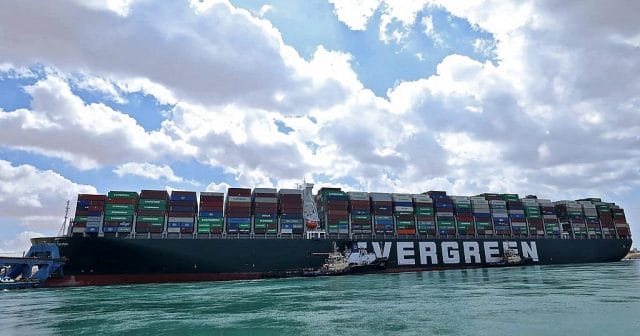
An attempt failed to re-float a giant container ship, the Ever Given, from the Suez Canal on Friday as the vessel has blocked one of the world’s busiest waterways.
Africanews takes a look at how it happened and what’s next.
How did it happen?
The 400-meter-long, more than 220,000-ton vessel deviated from course on Tuesday amid strong gusts of wind and a sandstorm that affected Egypt and parts of the Middle East.
The Ever Given – 59 meters wide and sixty high with its cargo – then got in the way in the south of the canal, near the town of Suez, blocking all navigation between the Mediterranean and the Red Sea in both ways.
The ship’s operator, Taiwan-based Evergreen Marine Corp, said the ship, which operated between the Chinese port of Yantian and Rotterdam in the Netherlands, ran aground “likely after being hit by a blast of wind”.
The incident “is mainly due to the lack of visibility due to the weather conditions, while the winds reached 40 knots (74 km / h,), which affected the control of the ship” flying the Panamanian flag, said The Suez Canal Authority (SCA) in a statement on Wednesday.
According to Bernhard Schulte Shipmanagement (BSM), the Singapore-based company responsible for the technical management of the vessel, the 25 crew members are safe.
And there was no pollution or damage to the cargo.
What are the consequences?
The Canal sees almost 10% of international maritime trade. Nearly 19,000 ships used the canal in 2020, according to the SCA, an average of 51.5 ships per day.
A study by German insurer Allianz said the blockage could cost global trade $6 billion to $10 billion a week.
Inaugurated in 1869, the canal has since undergone several phases of expansion and modernisation, in order to support changes in maritime trade.
Its breakthrough has drastically reduced the distances between Asia and Europe: 6,000 km less between Singapore and Rotterdam for example.
The canal has been blocked in the past, especially during the Suez Crisis in 1956 when ships were sunk by Egyptian authorities.
The specialist magazine Lloyd’s list said on Friday that more than 200 ships were stranded at both ends and in the waiting area in the middle of the canal.
The incident briefly affected global oil markets due to delivery delays.
The shipping giant Maersk and the German Hapag-Lloyd have also indicated that they plan to divert their ships to pass through the Cape of Good Hope, a detour of 9,000 kilometers around the African continent.
What’s next?
The SCA announced Thursday that maritime traffic was “temporarily suspended”.
The company commissioned for the “rescue” of the ship mentions “days or even weeks” before its recovery.
Since Wednesday, the SCA has been trying to clear the ship. It would take 15,000 to 20,000 cubic meters of sand to be removed to a depth of 12 to 16 meters and put the ship back into service, said SCA, which said on Friday that 87% of the sand removal process had been carried out by dredgers.
A significant high tide, expected early next week, could help the technical teams to unblock the ship.
Egypt has received several offers of international aid, notably from the United States and Turkey.
The Netherlands is also helping efforts and said its rescue team will send an additional two tugs on March 28.
The Suez Canal Authority (SCA) said efforts to free the ship by tug would resume as soon as dredging operations at its bow to remove 20,000 cubic metres of sand are complete.
“In addition to the dredgers already on site a specialised suction dredger is now with the vessel and will shortly begin work. This dredger can shift 2,000 cubic metres of material every hour,” it said.

